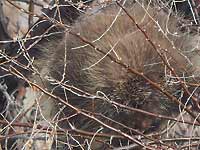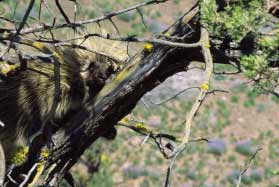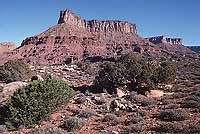Telltale signs of the thorny pig? S-curved tail drag marks along a sandy wash. Large, platter-like feet stippled with tiny marks called tubercles. A bow-legged gait split by the tail drag. Chew marks on the cottonwoods or pinyons or aspens. A whimpering dog with a snout full of quills. Yes, these are signs that the Canyon Country’s thorny pig has been around.
Better known as the porcupine, the genus name Erethizon means “thorny or quill pig,” these large rodents don’t need an introduction. Covered with as many as 30,000 quills (I wonder who the first naturalist to pluck one was) which are modified hairs, it’s an old wives-tale that says the porcupine can throw these quills. Instead, the quills, which may be over 5” long, lie flat on the back unless the animal is provoked. If so, the quills rise up like the hairs on a dog’s back signaling their attacker to back off. If attacked, the quills are easily loosened from the porcupine’s skin and embed themselves in the face of their attacker.
Tiny barbs on the quill’s tip make it stick like a harpoon. Removing the quills is a difficult affair, but at least they have an antiseptic-like coating that prevents infection. This is a safety measure for the porcupine should it ever be stuck by its own quills. Sedation might be required for a pet, but in the wild, the attacker may have to let the quill work its way through the skin to the other side.
There are no quills on the porcupine’s underbelly; you can imagine how difficult that would make climbing a tree. So when a predator like a cougar or a fisher is attacking a porcupine, they try to flip the animal onto its back and strike at the unprotected belly.
Smaller than their semi-aquatic relatives the beavers, porcupines prefer the safety of trees to sleep and eat in. Agile climbers, their long nails help them gain traction while climbing upwards or descending butt-first down a tree. This doesn’t mean they occasionally lose their grip or are forced to fall out of a tree by a predator. Broken ribs are not unusual for these creatures.
Though I have never heard porcupines calling, they are known to be quite vocal during their mating time in the fall. The sound is like a deep whining, almost owlish in quality but distinct. Unlike most rodents, a porcupine’s gestation period is close to seven months with the young born in May or June. Called “porcupettes,” the young are born with soft quills which harden in a few hours. Able to climb shortly after their birth, the young seek the protective confines of trees to avoid ground predators. 
In the wild, porcupines might live up to seven or eight years. Humans were once a threat to porcupines because they were considered forest pests and a bounty was placed on dead porcupines. The animals often girdle trees, causing them to die; hence, the porcupine was viewed as a threat to the health of a forest. The bounty did little to influence porcupine populations.
In winter, porcupines are more visible as they sleep or hide in deciduous trees. Their dark shapes and spiny silhouettes make them easily visible high up in a tree. I’ve also seen where these creatures have strolled along a wide rocky ledge to use a rocky alcove or jumble of rocks their den site. Active throughout the winter, these animals may also choose a hollowed out tree or one with a protective cavity where they can get out of the weather.
So the next time you encounter a set of odd animal tracks, follow them to see if you can find one of the interesting members of the Canyon Country’s fauna – the porcupine.



